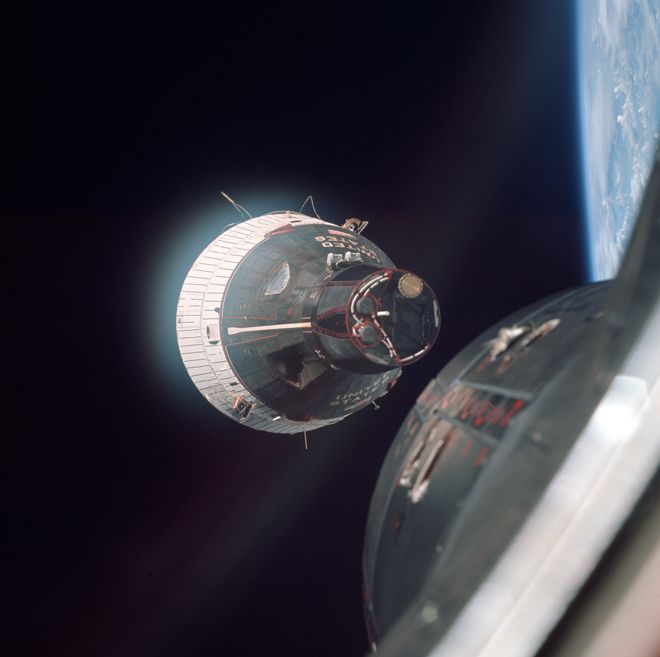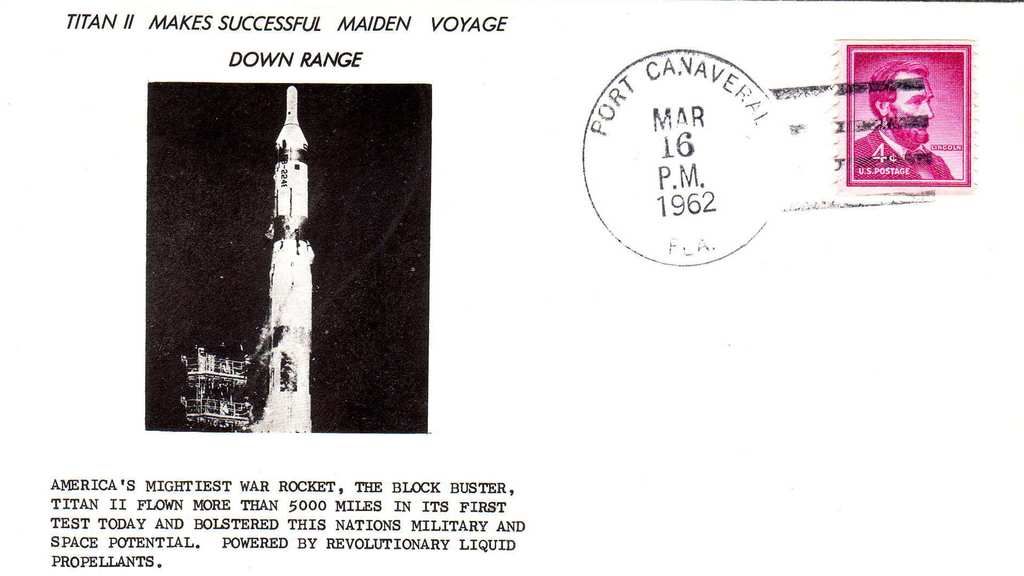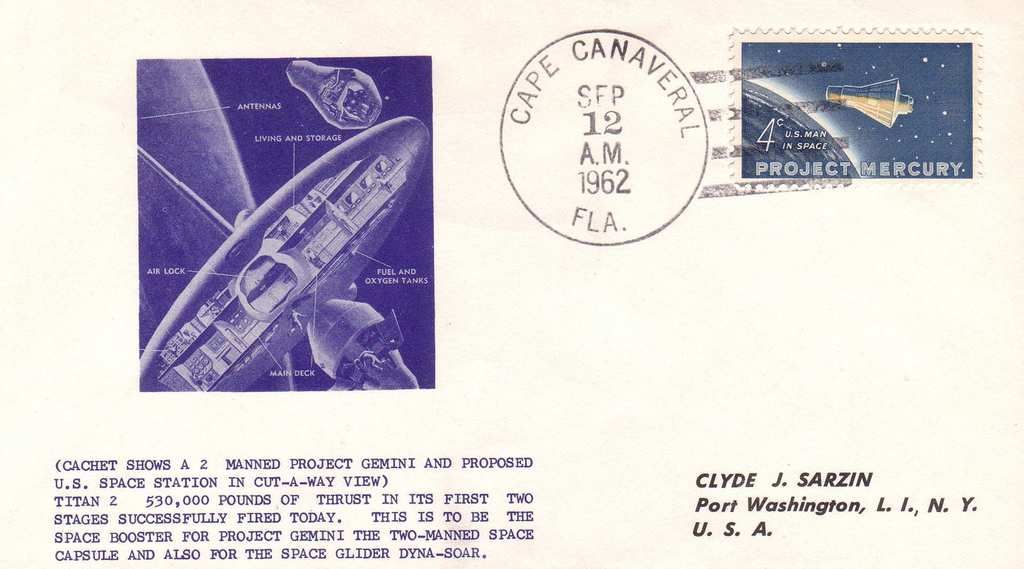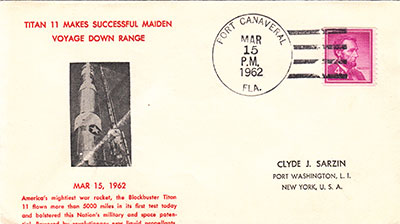|
|

|
|
Author
|
Topic: Space Cover 417: Early Gemini space covers
|
stevedd841
Member Posts: 299
From: Millersville, Maryland
Registered: Jul 2004
|
 posted 05-14-2017 07:23 AM
posted 05-14-2017 07:23 AM
   
Space Cover of the Week, Week 417 (May 14, 2017) A key objective of Project Gemini is to advance the program's transition to Apollo, to send astronauts to the moon and return them safely to Earth, photo credit NASA.Space Cover #417: Early Gemini Space Covers NASA Director Robert Gilruth calls it "Two-Man Mercury" or Mercury Mark II, but NASA Headquarters employee Alex Nagy wins the ad hoc naming contest and a bottle of Scotch whiskey by naming it Gemini. NASA's new Project is aptly named Gemini for its two-man astronaut crew, anticipated rendezvous missions in space, and a distinct zodiac relationship to Mercury. Alex Nagy thinks, "Even the astronomical symbol for Gemini fits the former Mark II designation.  The Clyde Sarzin cover pictured is postmarked on the first flight of the Titan II rocket launched at Cape Canaveral, Florida, March 16, 1962. This flight experiences severe longitudinal oscillation termed pogo effect and would have endangered the lives of Gemini astronauts on an actual flight. The Gemini Program Planning Board states that Titan II problems need to be addressed with utmost urgency.  A Sarzin cover for several new space projects including Project Gemini is displayed above for a Titan II rocket test, September 12, 1962, at Cape Canaveral. A subsequent Gemini man-rating rocket test for Titan II is evaluated with poor results on December 6, 1962. Could the pogo effect be fixed, and would Titan II be ready in time? Many space collectors consider this the starting cover for a Project Gemini collection, but as we can see, there are several earlier Gemini related covers that could claim this honor. The Titan II flight of November 1, 1963, is listed as a research and development flight, having pogo suppression fixes installed on both the rocket fuel oxidizer and fuel lines to dampen longitudinal oscillation. Results of this successful flight show a reading of only 0.11 due to these important engineering changes. The Titan II's pogo effect finally registers well below the 0.25's that NASA requires for astronaut safety.  A Robert Rank Space Velvet cover is pictured for the unmanned paraglider flight of May 28, 1964 at Edwards Air Force Base, California. The cover also has the second unmanned Gemini Titan-2 flight cancel of January 19, 1965. The spacecraft now shows some striking differences including a redesigned Gemini spacecraft in the lower part of the cachet much different that the spacecraft used for Project Mercury. This attractive Rank Space Velvet cover is from the author's collection. — Steve SU-4379 |
micropooz
Member Posts: 1703
From: Washington, DC, USA
Registered: Apr 2003
|
 posted 05-14-2017 04:00 PM
posted 05-14-2017 04:00 PM
   
Great topic Steve!A week before that first Titan II flight the Air Force static-fired the Titan II's first stage engines at the Cape. And there are covers for that event, shown below with a Port Canaveral hand cancel for March 9, 1962 and George Goldey Cachet.  And here's a cover for that November 1, 1963 Titan II flight, described by Steve above, where everyone breathed a sigh of relief that the pogo problem had been solved. This is a Swanson self-serve cachet machine cancelled at Cape Canaveral.  There is another Gemini paraglider cover out there, as described in SCOTW 25. |
Ken Havekotte
Member Posts: 3667
From: Merritt Island, Florida, Brevard
Registered: Mar 2001
|
 posted 05-14-2017 05:25 PM
posted 05-14-2017 05:25 PM
   
Nice coverage, Steve, on one of my favorite rockets, the Air Force/NASA-used Titan II launch vehicle.Sarzin's cover depicting the maiden flight of the new Titan II in March 1962 did feature the wrong printed cachet, though. He used an older Titan I version probably because there was no available or suitable, at the time, photo(s) to capture the newer Titan II rocket. The older Titan I was very much different in comparison to the newer version's upper and payload stages. The pogo oscillation, as you pointed out, was a serious problem in the early Titan rocket development program. But the same type problems didn't end there with Titan. The pogo effect again surfaced five years later with the early Apollo/Saturn V moon rockets as well. Perhaps the most famous pogo oscillation occurred during the launch and flight phase of Apollo 6 (AS-502) in April 1968. The first stage of the Saturn V went awry when longitudinal oscillations were detected during the last moments of the S-IC burn. In addition, on that same flight there had been major J-2 rocket engine failures of both the upper S-II and S-IVB stages. The pogo effect had been experienced on the maiden flight of NASA's new Saturn V as well in November 1967, but it wasn't quite so alarming as with the second Saturn V flight test. Of course, though, when the third Saturn V flew in Dec. 1968, with three crewmen rocketing to the moon, the telemetry readings from the S-IC reported that there were no longitudinal vibrations and that all staging operations and engine firings went smoothly. The pogo suppression system, once and for all, worked as planned. |
nasaliftoff
Member Posts: 13
From: FL
Registered: Apr 2017
|
 posted 05-14-2017 11:40 PM
posted 05-14-2017 11:40 PM
  
Here is a Sarzin Cachet from the 15th. |
stevedd841
Member Posts: 299
From: Millersville, Maryland
Registered: Jul 2004
|
 posted 05-24-2017 04:47 PM
posted 05-24-2017 04:47 PM
   
Many thanks, Dennis, Ken, and NASALiftoff, as always, I am amazed to see the depth of knowledge you guys add to my love of Project Gemini and early US Space Programs. Many, many thanks. NASAliftoff, I also was aware of the Sarzin cover for March 15, 1962, but in Astronautix.com, Mark Wade comments further: The 6555th Aerospace Test Wing launched the first Titan II (XLGM-25C) research and development flight test missile (N-2) from Cape Canaveral. The Titan II was the most powerful ICBM yet launched by the U.S., its first stage engines generating 430,000 pounds of thrust and the second stage engine 100,000 pounds. The flight of N-2 also marked the first successful test of the AC Spark Plug inertial guidance system. The Air Force successfully launched a Titan II intercontinental ballistic missile. This was the first full-scale test of the vehicle; it flew 8000 km out over the Atlantic Ocean. Many thanks! | |
Contact Us | The Source for Space History & Artifacts
Copyright 2023 collectSPACE.com All rights reserved.

Ultimate Bulletin Board 5.47a
|
|

|
 advertisement advertisement

|


















